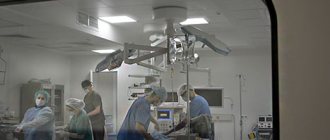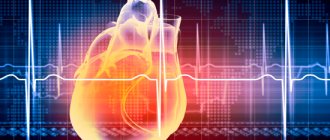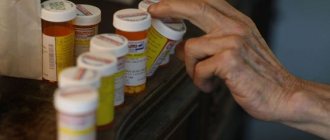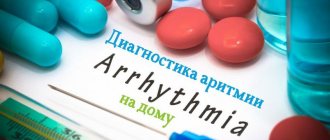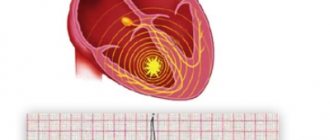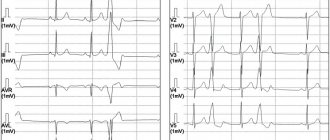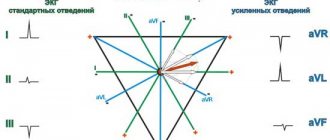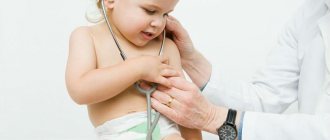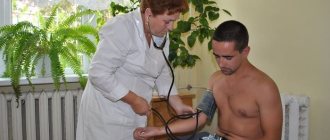Causes of arrhythmia in childhood
Arrhythmia in children may have different causes, but for accuracy and ease of diagnosis, they are all divided into three main groups.
- Heart. This includes any defects found during the formation or development of the heart, for example, problems with the interatrial septum, Ebstein's anomaly. In addition, this includes the consequences of severe infections, serious viruses, autoimmune failures, and various inflammations that had a negative impact on the functioning of the heart organ. This could be rheumatism, myocarditis, vasculitis, hypertrophic cardiomyopathy, severe tonsillitis, sepsis, bronchitis, etc.
- Extracardiac. This should include hypoxia, prematurity of the fetus, lack of nutrition in the womb, which prevented the harmonious development of the heart. It may also be an abnormal heart rhythm due to hormonal imbalances, for example, hypothyroidism, blood diseases (in particular, iron deficiency anemia), severe stress, prolonged emotional stress, vegetative-vascular dystonia and other reasons.
- Combined. This group includes causes from both previous categories and requires especially careful diagnosis by cardiologists and other specialized specialists.
Classification of arrhythmia in children
The classification of this disease is established for the fastest, most accurate and effective diagnosis of arrhythmia in a particular patient and the selection of the most suitable treatment tactics for him.
Today, cardiac arrhythmia in children is divided into the following categories:
- bradycardia and sinus tachycardia. Bradycardia is a decrease in heart rate by more than 30 beats per minute from the established norm. Tachycardia, on the contrary, implies the same change, but in the direction of increase;
- sinus arrhythmia. The most common option. It usually appears in school-age children and is often accompanied by changes in respiratory rhythm. The main reason is excessive emotional, mental and physical school stress;
- rhythm source migration. Arrhythmia in a child, which appeared due to the fact that not the sinus node, but another element of the cardiac system caused a change in the frequency of contractions of the heart muscle;
- extrasystole or one or more extraordinary cardiac contractions. May be atrial or ventricular. It is registered at the time of diagnosis, as it does not have pronounced symptoms;
- paroxysmal tachycardia. Severe increase in heart rate, exceeding 160 beats per minute. Usually accompanied by nervousness, anxiety, pain or discomfort in the chest area;
- atrial fibrillation. Appears as a result of injuries and other lesions of the main human organ. The heart chambers begin to contract dispersedly, in a chaotic manner, without coordination with each other;
- failure of conductive function. Most often these are blockades recorded during an ECG in a child.
There is also another, smaller classification of arrhythmia in a child, based on its external manifestations:
- asymptomatic – has no clinical manifestations and does not interfere with the standard development and growth of the child;
- arrhythmia with a stable clinical picture - affects the well-being of the young patient and affects the state of health.
Features of pathology during puberty
Very often, adolescent children are susceptible to rhythm disturbances, which is associated with hormonal changes characteristic of this period. Imbalance of hormones affects the functioning of the cardiac and vascular systems, which is manifested by dysfunction of the autonomic system.
According to studies, during examination, 85% of adolescents are diagnosed with respiratory sinus arrhythmia
During puberty, sinus arrhythmia predominantly develops, when the heart rate does not correspond to normal physiological indicators due to the breathing process. The condition develops after physical exertion, stress, mental stress, and while taking medications. This type of respiratory ventricular tachyarrhythmia does not require special therapy, since the condition stabilizes after the normalization of hormonal processes in the body.
True sinus arrhythmia in a teenager is not associated with breathing; it develops as a result of a disturbance in the conduction of cardiac impulses by the pacemaker. A disorder of this function may indicate the presence of cardiac diseases of infectious origin in the child or provoke previously undetected anomalies.
Manifestations of arrhythmia in childhood
Not in every case can the disease be identified by its symptoms: it is often discovered only during a routine examination by a doctor prescribed by age.
Symptoms of arrhythmia in infants
In the first year of life, arrhythmia in children has the following symptoms:
- shortness of breath that appears in attacks: it began abruptly and disappeared just as suddenly;
- pale or blue skin;
- increased moodiness, restless behavior;
- loss of appetite;
- disordered sleep;
- low weight gain, insufficient for age norms;
- strong pulsation of blood vessels in the neck.
Symptoms of arrhythmia in older children
Arrhythmia in an older child manifests itself as follows:
- fast fatiguability;
- difficulties with exercise tolerance;
- discomfort in the sternum and heart area;
- low blood pressure;
- fainting and presyncope.
Diagnosis of the disease in children
For children of different ages, there are established norms for the frequency of contractions of the heart muscle. So, for example, at birth it is about 140 beats made in 1 minute, but per year it already decreases to 120, etc.
It is possible to determine to what extent the situation in a particular child deviates from normal indicators using special diagnostic methods.
First of all, a test ECG is prescribed in three options: in a sitting position, lying down, and then after a slight load. This makes it possible to monitor whether there are rhythm disturbances in a young patient. Additionally, daily ECG monitoring may be prescribed, carried out over 24 hours. The procedure does not complicate the child’s life, does not interfere with his motor activity and can be performed at absolutely any age.
The cardiologist may also recommend stress tests that demonstrate hidden malfunctions in the cardiovascular system, and pharmacological tests.
Development mechanism
The development of pathology in childhood is facilitated by the peculiarities of the structure and functioning of the heart muscle. Thus, the development of rhythm disturbances is caused by pathological changes in the formation of impulses, the conduction of excitation, as well as their combination.
An important role in the formation of dysrhythmia is played by an imbalance in the ratio of the number of potassium, magnesium and sodium ions inside the myocardium
There are several mechanisms for the development of pathology:
- Due to inhibition of the activity of the sinus node, the pacemaker migrates.
- Disturbances in the spread of excitation as a result of the formed block.
- A disorder of impulse conduction associated with its movement in a circle.
When should you see a doctor?
Any diseases in the heart area are dealt with by a pediatric cardiologist. He should be visited as soon as parents notice something in their baby’s condition that worries them, for example, blue discoloration of the nasolabial triangle, frequent fainting and other symptoms. You should not hesitate to consult if the child complains of burning, pain or pressure in the sternum.
It is important to seek help right at the very beginning, because any illness is easier and faster to cure in the initial stages of its development.
Much depends on the doctor’s level of qualification: he must specialize in children, have extensive work experience and have progressive views on treatment methods, that is, be aware of all the discoveries in the world of cardiology and pediatrics.
These are the specialists who work in the pediatric department of JSC “Medicine” (academician Roitberg’s clinic), located in the center of Moscow at 2nd Tverskoy Lane, 10, a five-minute walk from the Mayakovskaya metro station. In the immediate vicinity there are also metro stations “Tverskaya”, “Novoslobodskaya”, “Chekhovskaya”.
You can register your child for a consultation with a specialist by calling +7 or using the feedback form. Here you can find out information of interest about the cost of admission and the level of qualifications of all specialists.
Reasons for formation
The causes of rhythm disturbances can be various etiological factors, which experts have divided into three main groups:
- Cardiac (primary damage to the heart muscle, which leads to functional disorders in the functioning of the organ).
- Extracardiac (develops against the background of conditions that are accompanied by insufficient oxygen supply to myocardial cells).
- Combined (combine etiological factors of the first and second groups).
As a rule, in childhood, cardiac causes are not primary in the development of arrhythmias, but when pathology is detected, they must be excluded first.
The causes of pathology of cardiac origin are congenital and acquired defects of the anatomical structures of the heart
There are the following causes of cardiac rhythm disturbances:
- Congenital cardiac anomalies (tetralogy of Fallot, atrioventricular communication).
- Acquired heart defects.
- Congenital and acquired myocarditis, pericarditis due to exposure to infectious agents.
- Hypertrophic cardiomyopathy.
- Neoplasms in the structural elements of the heart.
- Anomalies in which additional anatomical structures are formed.
- Mechanical damage during invasive procedures in the cardiac region.
- Organ injuries accompanied by hemorrhage.
- Toxic effect of drugs.
In most cases, rhythm disorder is preceded by damage to the nervous and autonomic systems as a result of pathological processes during pregnancy and childbirth, which leads to disruption of the coordinated activity of the myocardium.
Extracardiac etiological factors include:
- intrauterine hypotrophy;
- prematurity;
- pathologies of the central nervous system and VSD;
- endocrine diseases.
During puberty, arrhythmia develops as a result of mental stress when the nervous system is stressed. Adolescents who engage in intensive sports during a period of intense growth of the heart muscle are also susceptible to rhythm disorders.
Treatment of arrhythmia in children
Arrhythmia in children requires complex treatment, in which parents must work in tandem with the doctor. First of all, it is necessary to establish an appropriate daily routine, devoting enough time to proper rest, mental exercise, physical activity, and avoiding stressful situations.
Depending on the characteristics of the manifestation and cause of the disease, drug or surgical therapy is selected. However, treatment is necessarily aimed at identifying the cause of the disease and getting rid of it. So, for example, if an increased heart rate causes chronic infectious diseases such as adenoiditis, caries and others, then you need to take care of them first.
Prognosis for the treatment of arrhythmia
With a competent integrated approach and timely treatment, the situation has a favorable outcome. The course of this disease largely depends on the specific provoking cause that caused it, as well as the availability of opportunities for its elimination.
Heart rhythm disorders of a functional nature are the easiest to treat. Atrial fibrillation requires increased attention from the child’s parents and pediatric cardiologist due to the serious risks it carries. These include heart failure and thromboembolic problems.
In the event that cardiac arrhythmia in children is caused by any organic heart lesions, special attention is paid to it, since sudden infant death is among the possible complications.
Therapeutic measures
Treatment of functional arrhythmia does not require special methods; parents need to organize proper care for their children and create conditions to prevent the progression of the pathology. To eliminate the clinical form of the disease, conservative therapy and modern surgical techniques are used.
The primary goal of treatment is to eliminate foci of chronic infection that cause worsening cardiac diseases
Drug treatment includes the use of the following groups of drugs:
- Antiarrhythmic drugs (Flecainide, Quinidine, Bepridil).
- Improving myocardial function (Cavinton).
- Neuroleptic drugs (Chloral hydrate, Haloperidol).
- Nootropic drugs (Trental).
- Antioxidants (Vitamin A, E, C, Xidifon).
Dysrhythmias that are resistant to conservative treatment require the use of minimally invasive surgical techniques:
- radiofrequency ablation;
- cryoablation of arrhythmogenic pathological areas;
- implantation of a pacemaker.
Arrhythmia, accompanied by fluttering or flickering of the heart structures, requires immediate hospitalization and intensive care.
Prevention of the disease
Preventive measures to prevent the occurrence of arrhythmia will not be superfluous either for children with heart rhythm disturbances or for absolutely healthy children.
First of all, irritating factors should be eliminated, concomitant diseases that can increase the load on the heart should be thoroughly treated, and routine examinations of the functioning of the cardiovascular system should be periodically carried out.
Along with visiting a pediatric cardiologist, it may be necessary to visit a pediatrician, pediatric endocrinologist, hematologist and rheumatologist.
In addition, it is important to protect the child from hypothermia, to prevent the development of chronic foci of all kinds of infections, and to avoid viral diseases as much as possible.
Strengthening natural immunity is of great importance, which requires:
- establish proper sleep;
- take care of a rational, balanced diet with sufficient content of all necessary vitamins and minerals;
- maintain a water regime: drink daily the norm of clean water established by age;
- carry out gradual hardening;
- spend time in the fresh air as often as possible;
- reduce the level of stress (especially important for schoolchildren).
In the fight for good health of the child’s cardiovascular system, one method, in most cases, is not enough. Often it is necessary to resort to both medication and preventive measures. It is extremely important not to stop there, and even after the arrhythmia is defeated, to maintain a healthy daily routine.
Research methods
Detection of cardiac rhythm disturbances is not difficult in terms of diagnosis, since already during auscultation the pediatrician can recognize pathological noises and refer the child to undergo additional research methods to clarify the diagnosis.
When collecting anamnesis, the cardiologist takes into account the baby’s genetic predisposition to diseases of the cardiovascular system.
During an objective examination, a specialist can diagnose a rapid heartbeat, irregular myocardial contraction, and a rare pulse compared to the age norm.
Research plan for detecting cardiac rhythm disorders:
- Electrocardiography. Allows you to identify pathological changes in the pacemaker and disorders of autonomic cardiac regulation. It is carried out in several positions (horizontal, vertical) and after physical exercise.
- Holter monitoring. Detects cardiac fluctuations during the day, carried out by installing a special sensor. The technique is available for both older children and newborns.
- Stress tests. These include bicycle ergometry and drug loading. Allows you to determine the resistance of the heart to various loads, as well as identify hidden conduction and rhythm disorders.
- Drug tests. In pediatrics, atropine and potassium-obsidan tests are widely used, which assess the functional state of the autonomic and conductive systems.
- X-ray of the cervical spine. Assessment of peripheral and cerebral circulation.
- EchoKg. The study is used when there is a suspicion of possible congenital and acquired anomalies in the development of the heart, which provoke dysrhythmia.
The procedure for recording cardiac impulses using an ECG
One of the specific examination methods is a virological study, since experts have proven the ability of viral agents to provoke myocardial damage. A particularly aggressive herpes virus that can remain in the body throughout life.
